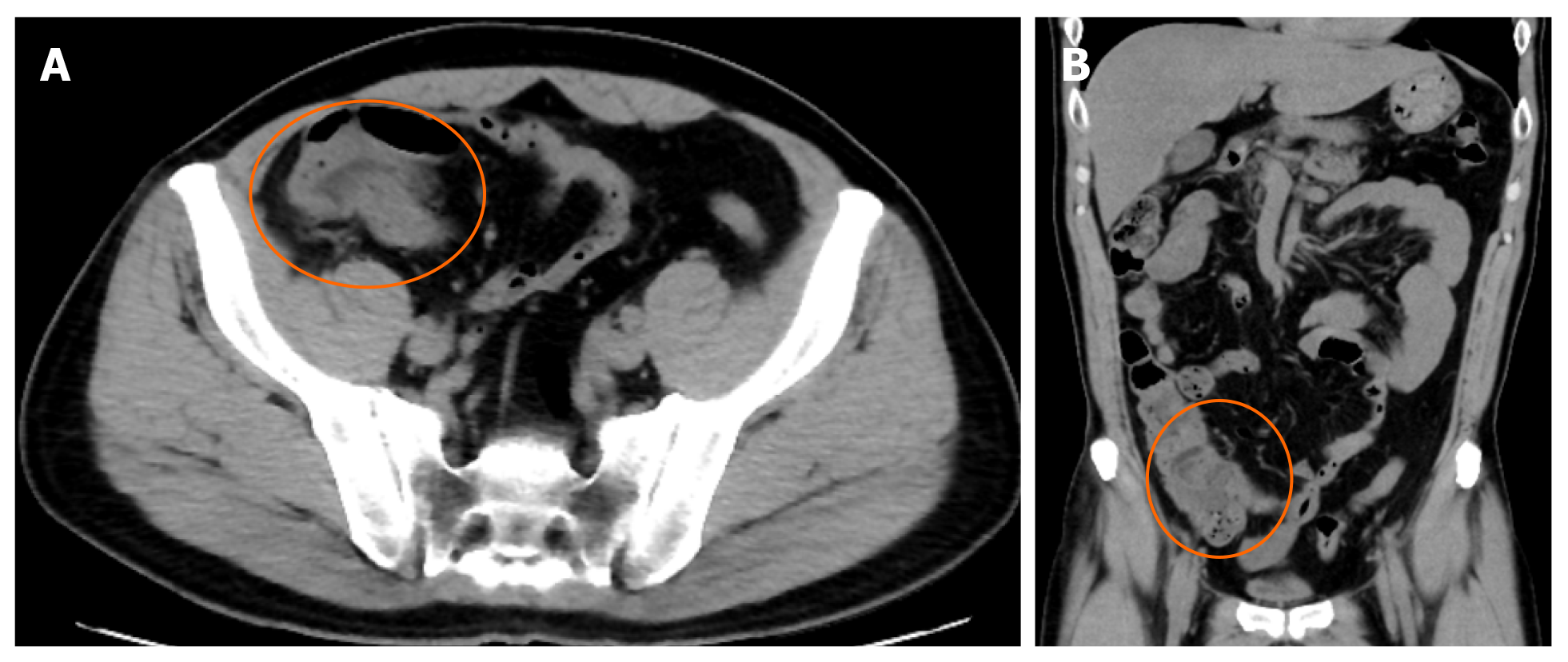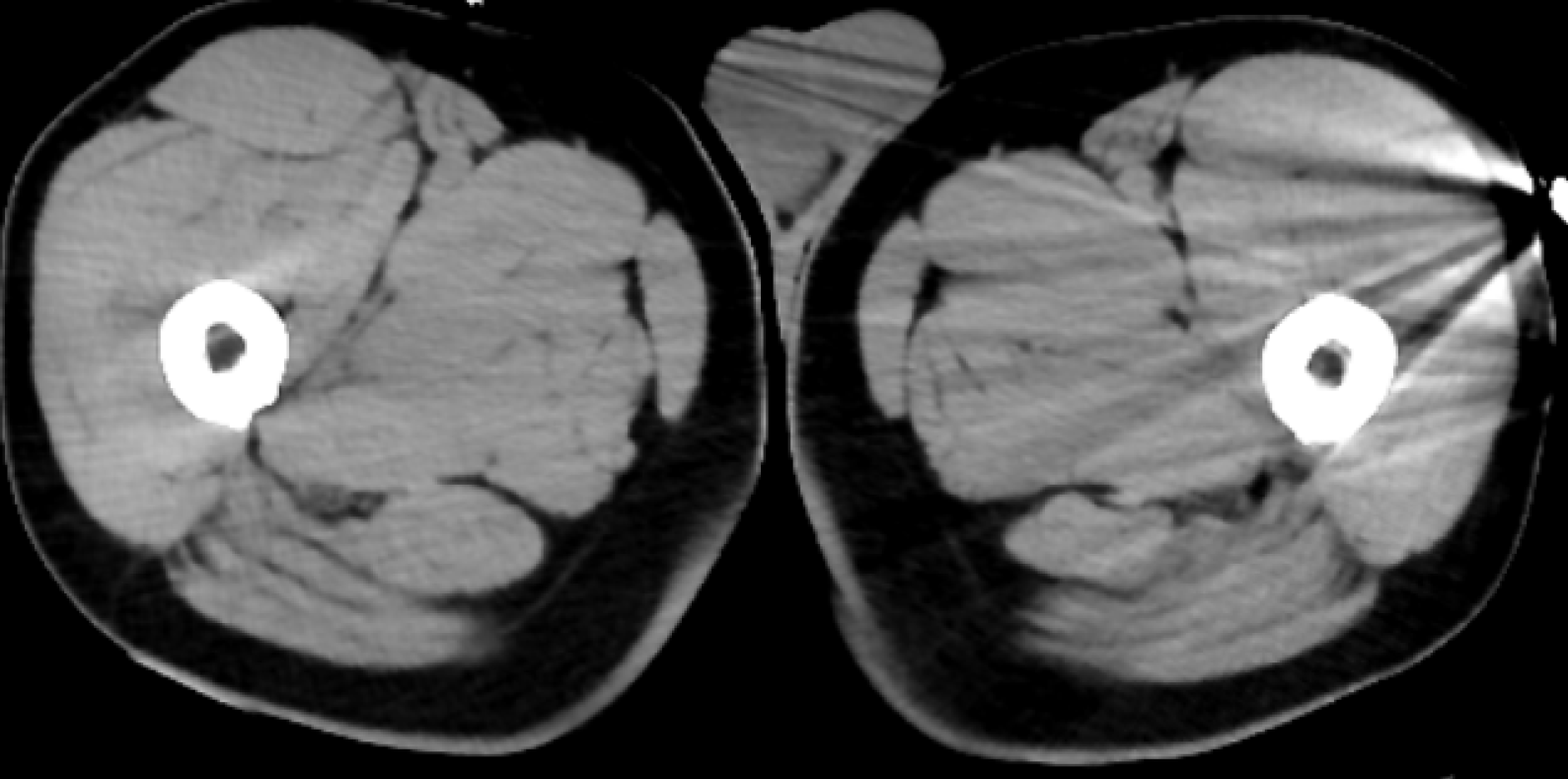Published online Aug 6, 2020. doi: 10.12998/wjcc.v8.i15.3280
Peer-review started: March 15, 2020
First decision: April 7, 2020
Revised: April 23, 2020
Accepted: July 14, 2020
Article in press: July 14, 2020
Published online: August 6, 2020
Processing time: 144 Days and 6.9 Hours
Common symptoms of Campylobacter colitis include abdominal pain, vomiting, diarrhea, and fever, among others. However, Campylobacter colitis also has a high incidence of extraintestinal symptoms.
We report the case of a 51-year-old man who presented with bilateral testicular pain. A scrotal examination failed to reveal any physical findings, but the patient exhibited mild tenderness in the right lower abdomen. Computed tomography revealed ileocecal wall thickening. Post-admission, the patient developed diarrhea, and a stool culture was submitted; Campylobacter jejuni infection was confirmed. Testicular pain is known to be caused by appendicitis. Consequently, we suggest that Campylobacter colitis, which causes ileocecal inflammation, caused the testicular pain in this case.
In patients with testicular pain and no other objective findings, diseases such as Campylobacter colitis should be considered.
Core tip: In cases of testicular pain without other objective findings, ileocecal inflammation-causing diseases, such as Campylobacter colitis, should be considered in the differential diagnosis.
- Citation: Sanagawa M, Kenzaka T, Kato S, Yamaoka I, Fujimoto S. Campylobacter jejuni enterocolitis presenting with testicular pain: A case report. World J Clin Cases 2020; 8(15): 3280-3283
- URL: https://www.wjgnet.com/2307-8960/full/v8/i15/3280.htm
- DOI: https://dx.doi.org/10.12998/wjcc.v8.i15.3280
Campylobacter jejuni is the most common bacterial enteropathogen, and infections with this organism are typically accompanied by abdominal pain, vomiting, diarrhea, and fever. In contrast, Campylobacter colitis has been reported to cause various extraintestinal symptoms[1]. Approximately 40% of patients with Campylobacter colitis present with musculoskeletal symptoms, 15% present with ocular symptoms, and 17% present with urinary tract symptoms. Urinary tract symptoms can include urethral inflammation, which may cause frequent urination and pain during urination[1]. In this report, we document a case where Campylobacter colitis was accompanied by testicular pain.
A 51-year-old man presented to our hospital with bilateral testicular pain.
He had eaten raw chicken (sashimi, in Japanese) a few days before the onset of his symptoms. The testicular pain onset was gradual, beginning in the morning prior to his visiting the hospital. Throughout the day, his testicular pain had spread to his entire back and abdomen and had increased in intensity, leading him to visit our hospital that evening. He also experienced fever, headache, and general joint pain, but no nausea or diarrhea.
The patient did not have a history of significant past illnesses.
Physical examination revealed a body temperature of 38.1 °C, a heart rate of 109 beats/min, a blood pressure of 138/76 mmHg, and a respiratory rate of 20 breaths/min. He exhibited mild tenderness over a wide area, which centered in his right lower abdomen. However, his scrotum did not exhibit any abnormal findings, such as redness, swelling, warmth, or tenderness.
Blood tests showed slight increases in his white blood cell count [12360 cells/µL, (neutrophils: 81.9%)] and C-reactive protein level (1.26 mg/L); no abnormalities were detected in the patient’s urinalysis.
Abdominal computed tomography imaging revealed thickening of the ileocecal walls (Figure 1), but his scrotal area appeared normal (Figure 2).
Campylobacter colitis.
The patient was hospitalized and treated with fasting, fluid replacement, and 1 g of ceftriaxone, administered intravenously every 24 h. On the night of his admission, he developed watery diarrhea; a stool sample was submitted for culturing.
His fever and testicular pain resolved on post-admission day 3; he was discharged on day 6. After discharge, his stool culture results were reported and revealed the presence of C. jejuni, confirming the Campylobacter colitis diagnosis; his urine culture was negative for the presence of bacteria.
Here, we report, to the best of our knowledge, the first case of Campylobacter colitis accompanied by testicular pain. Clinicians should be particularly aware of the fact that Campylobacter colitis often presents with extraintestinal symptoms[1]. The more common symptoms of the disease include abdominal pain, vomiting, diarrhea, and fever. In addition, about 40% of patients present with musculoskeletal symptoms, which may include Reiter's syndrome-like arthritis[1]. Further, patients may manifest both eye and urinary tract symptoms[1]. The urinary tract symptoms, caused by urethral inflammation, include increased urinary frequency and dysuria[1]; however, previous reports have not suggested that this inflammation induces testicular pain.
The differential diagnosis for testicular pain includes testicular torsion, epididymitis/orchitis, testicular infarction, and scrotal edema[2]. In addition, a few reports have documented testicular pain associated with appendicitis[3-5], but none have reported testicular pain associated with ileocecal inflammation. The testicular pain associated with appendicitis is thought to be related to the tenth thoracic spinal nerve, which innervates both the appendix and the testes[6]. In the present patient, because ileocecal inflammation is a hallmark of Campylobacter colitis, the inflammation may have spread from the ileocecal region to the appendix.
Given the absence of physical findings, such as scrotal tenderness, and the normal urinalysis results, we surmise that the patient’s testicular pain was caused by inflammation of the appendix. This hypothesis is supported by the simultaneous resolution of the testicular pain and the resolution of his colitis symptoms, which included fever, abdominal pain, and diarrhea. The testicular pain appeared as an early symptom, before the onset of diarrhea. This is similar to the onset of appendicitis, which may include related (indirect) epigastric and/or testicular pain. Campylobacter colitis is often preceded by extraintestinal symptoms, such as fever and headache, and the onset of diarrhea is often delayed. The inflammation that is often present in the ileocecal area is presumed to cause the delayed onset of diarrhea[7]. In the present patient, the reported testicular symptoms were bilateral, but the location of the pain may have been unclear because it was related, rather than direct, pain.
This is the first report of testicular pain associated with Campylobacter colitis. Given that Campylobacter colitis causes ileocecal inflammation, our case suggests that ileocecal inflammation may indirectly cause testicular pain. Thus, ileocecal inflammation should be considered in the differential diagnosis of patients with testicular pain.
Manuscript source: Unsolicited manuscript
Specialty type: Medicine, research and experimental
Country/Territory of origin: Japan
Peer-review report’s scientific quality classification
Grade A (Excellent): 0
Grade B (Very good): 0
Grade C (Good): C, C
Grade D (Fair): 0
Grade E (Poor): 0
P-Reviewer: Dai Y, Sitkin S S-Editor: Wang JL L-Editor: A E-Editor: Li JH
| 1. | Schönberg-Norio D, Mattila L, Lauhio A, Katila ML, Kaukoranta SS, Koskela M, Pajarre S, Uksila J, Eerola E, Sarna S, Rautelin H. Patient-reported complications associated with Campylobacter jejuni infection. Epidemiol Infect. 2010;138:1004-1011. [RCA] [PubMed] [DOI] [Full Text] [Cited by in Crossref: 22] [Cited by in RCA: 23] [Article Influence: 1.4] [Reference Citation Analysis (0)] |
| 2. | Knight PJ, Vassy LE. The diagnosis and treatment of the acute scrotum in children and adolescents. Ann Surg. 1984;200:664-673. [RCA] [PubMed] [DOI] [Full Text] [Cited by in Crossref: 82] [Cited by in RCA: 65] [Article Influence: 1.6] [Reference Citation Analysis (0)] |
| 3. | Wilkins SA, Holder LE, Raiker RV, Wilson TH. Acute appendicitis presenting as acute left scrotal pain: diagnostic considerations. Urology. 1985;25:634-636. [RCA] [PubMed] [DOI] [Full Text] [Cited by in Crossref: 12] [Cited by in RCA: 15] [Article Influence: 0.4] [Reference Citation Analysis (0)] |
| 4. | Dienye PO, Jebbin NJ. Acute appendicitis masquerading as acute scrotum: a case report. Am J Mens Health. 2011;5:524-527. [RCA] [PubMed] [DOI] [Full Text] [Cited by in Crossref: 3] [Cited by in RCA: 3] [Article Influence: 0.2] [Reference Citation Analysis (0)] |
| 5. | Najafizadeh-Sari S, Mehdizadeh H, Bagheri-Baghdasht MS, Manoochehry S. Suppurative appendicitis presenting acute scrotal pain: a rare condition may confuse surgeons. J Surg Case Rep. 2017;2017:rjx215. [RCA] [PubMed] [DOI] [Full Text] [Full Text (PDF)] [Cited by in Crossref: 5] [Cited by in RCA: 5] [Article Influence: 0.6] [Reference Citation Analysis (0)] |
| 6. | Silen W. Cope's early diagnosis of the acute abdomen. 22nd edition. Oxford: Oxford University Press 2010; 75-76. |
| 7. | Bennett JE, Dolin R, Blaser MJ. Mandell, Douglas, and Bennett's Principles and Practice of Infectious Diseases. 9th edition. Philadelphia: Elsevier 2019; 2654. |










